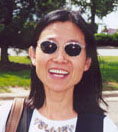Hello
From Shanghai - Page 3

"Where
are all these children from?", I asked Ms. Wu.
Ms. Wu responded to this question without any hesitation: From places
such as the train station, stores, the hospital, elementary schools, private
residences, or by leaving a child with a stranger on board a train or
in the waiting room of the station. Some with physical handicaps were
even found in dumpsters, public restrooms or rice patties. Judging by
a child's clothing or a piece of clothing wrapped around the baby, you
can tell that all of these children are from rural areas.
"What
do you feel when you accept one of these children?"
She said that she believes that the parents should be severely punished.
Now the government has to pay the expenses for someone else who should
have taken the responsibility. Pointing to a boy who has a large
birthmark on his right cheek, she said, "His parents abandoned him
just because of this mark!"
I kept asking
about the children's gender, since all the children were dressed in different
clothes and it was sometimes difficult to tell. Mr. Huang said they
prefer to have the children dressed as individuals, rather than wearing
uniforms, as they do in many of the other institutions. As per the
children's clothing, all of the children are dressed in westernized pants,
without the open crotch, split pants so common in other parts of China.
Unlike the ratio
in the nursery room, the ratio between children and caretakers are much
larger in the kindergarten and elementary groups. In this section, there
were 8 adults taking care of 28 infants. Adult caretakers work in
24 hour shifts.
Next, we toured the Zhenchan School, founded by Master Zhenchan,
the Chairman of the Shanghai Buddhism Association. This school provides
special education for the aged 4 to 16. The kindergarten and elementary
age children are divided into 4 groups according to their ages. In
each classroom, there was one teacher/caregiver and from 24 to 28 children.
In each of the rooms, the children were sitting around two large rectangular
tables, playing with plastic Legos and wooden puzzles, and drawing and
coloring pictures.
"How do
you name these children?"
We give each child
a family name by looking it up in the Handbook of One Hundred Family
Names. All of the children coming into the institution during
the same month would have the same last names. Li (Lee) is the family
name for all the children accepted by the institution this month, June
2000, the room teacher tells me.
The other two
classrooms at the end of the building are for teenagers. A group
of 8 young boys and girls were eating chicken stirred with water bamboo
shoots. One of the young girls was doing the cooking. She
scooped some chicken and bamboo shoots to my plate with a shy smile. The
teenagers have cooking class twice a week, as part of their curriculum.
The last room
in the building is a library with many children's books and 20 computers
that are separated by the book cases. About 10 students, slightly
older than the cooking group, are using the computers. They are
working on their writing and computer skills, by copying stories out of
picture books. Using Chinese software, they type in Pinyin letters
and select Chinese characters to make sentences.
To Be Continued...
INDEX  1 2 3
4 1 2 3
4 
|

